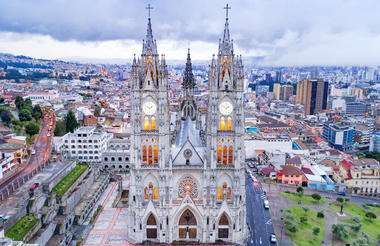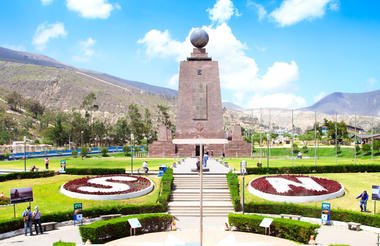Puembo is a tranquil, pretty farming town located east of Quito, in the district of the same name, set ten minutes from the international airport. It functions as one of the best bases for hiking the magnificent inactive volcanoes in the area, such as Ilalo and Coturco. Ilalo, a striking triangular-shaped peak, is decorated with numerous wonderful hot springs, and there are several excellent spas to enjoy. Coturco is a large landmark volcano that can be seen from miles away, swathed in the beautiful dense pine forest, and offers both challenging hikes and a road to the summit for spectacular views. History and architecture enthusiasts visiting Puembo should make sure to see the Old Chapel, and head to Quito for fascinating heritage buildings and museums. Puembo is also known for its rich traditions and holds a wonderful celebration over Holy Week.


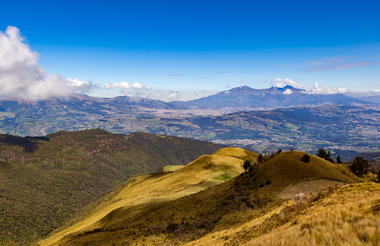
Situated on Santa Cruz Island of the Ecuadorian Galapagos Islands, the tourist town of Puerto Ayora is famous for its striking natural scenery, breathtaking beaches, and unique history. As the biggest town in the archipelago, it is from here that many excellent cruises, diving expeditions and land based tours depart. Tortuga Bay, which rivals any South American beach, is perfect for swimming and sunbathing and also offers the chance to spot sharks, marine iguanas, pelicans, and the occasional flamingo, while the Charles Darwin Research Station is home to giant tortoises. Other-worldly lava tunnels and two idyllic lagoons provide further opportunities to explore. The incredible Maprae Museum uses smartphone technology and augmented reality to tell the stories of ancient pre-Columbian artifacts.



Located in the central part of the Galápagos archipelago, the small, flat island of Baltra (also known as South Seymour Island) is the only island not included within the Galápagos National Park, as it serves primarily as the site of the archipelago’s main airport and a small Ecuadorian military base. With its starkly arid landscape and sparse vegetation of prickly pear cacti, salt bushes and palo santo trees, arriving here can feel like landing on another planet. As Baltra is a designated non-visitor site, travellers are swiftly transferred by bus to one of two docks, where they board either a cruise ship or a ferry bound for nearby Santa Cruz Island.



The island of Santa Cruz is home to Puerto Ayora, the largest and most developed town in the Galapagos. Although many travellers use it as a springboard to explore the more remote surrounding islands, those who venture deeper will find that Santa Cruz has much to offer in its own right. With numerous visitor sites, easily accessible beaches, and remote highlands at its heart, the island serves as an excellent base for adventure. Its most renowned attraction, the Charles Darwin Station, features an impressive turtle breeding programme and fascinating displays on the conservation of the Galapagos’ unique biosphere. Visitors can also swim or snorkel at the island’s magnificent beaches, where white sand and turquoise waters are alive with pelicans, blue-footed boobies, and marine iguanas.
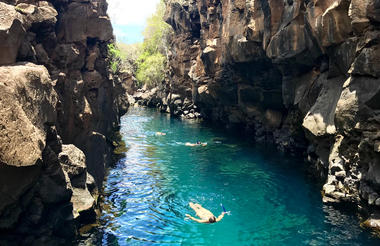
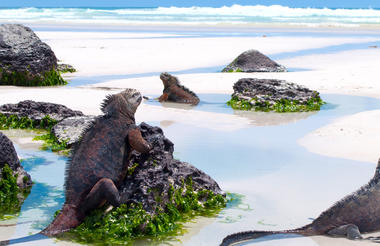

San Cristóbal is the easternmost island in the Galapagos archipelago as well as the most populated. Famous for its natural attractions, the island also boasts some wonderful shopping and dining opportunities as well as a local airport. Take a break from snorkeling and hiking to enjoy the best Ecuadorian cuisine, or admire some of the exquisite artwork and designs at local galleries and markets. Must-see attractions include the Galapaguera Tortoise Reserve; the Interpretation Center (which provides important background information on the Galapagos); and Puerto Grande, a protected cove on the north-western side of the island boasting a magnificent white sandy beach - ideal for a peaceful walk, swim or photography sesssion.



Set just off the northwestern coast of San Cristóbal, the small islet of Isla Lobos offers a peaceful haven for wildlife within the Galápagos Islands. This flat, rugged island is best known for its lively sea lion colonies, blue-footed boobies, magnificent frigate birds, and marine iguanas basking along the rocks. Travellers can expect excellent snorkelling in the surrounding clear waters, where sea turtles, rays and colourful schools of fish glide through the shallows. With its quiet, white-sand patches, gentle turquoise bays, and abundant birdlife, Isla Lobos offers an intimate glimpse of Galápagos nature, perfect for visitors seeking close, responsible encounters with the archipelago's iconic coastal wildlife.
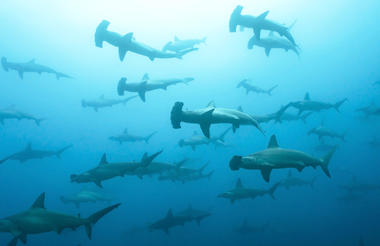
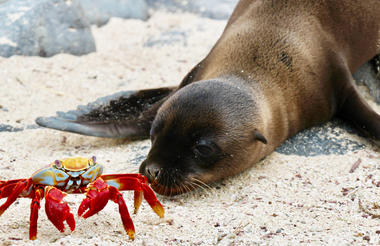
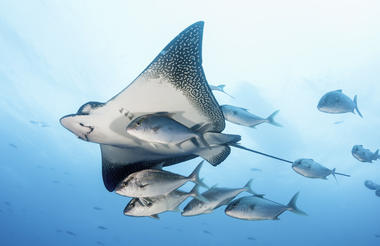
Perched at the southern edge of the Galápagos archipelago, Española Island, Ecuador, exudes a raw, untamed beauty. Its windswept cliffs, golden beaches, and rugged lava formations create a dramatic backdrop where wildlife reigns supreme. Visitors are captivated by the island’s most famous residents: seasonally, thousands of waved albatrosses perform intricate courtship dances, playful sea lions basking on sun-warmed rocks, and vibrant marine iguanas dotting the shores. Snorkelling in crystalline waters reveals a kaleidoscope of tropical fish, while the rhythmic crash of waves against cliffs underscores the island’s isolation. Accessible only via guided tours, Española offers a tranquil yet exhilarating encounter with nature, rewarding travellers with rare glimpses of one of the world’s most pristine and extraordinary ecosystems.



As previously described



Resting approximately 12 kilometres southeast of Santa Cruz, the relatively small island of Santa Fe is one of the oldest islands in the Galapagos archipelago with rock formations below the water’s surface dating back almost four million years. The island is best known for its endemic Barrington Land Iguana as well as its towering prickly pear cacti which have been known to reach remarkable heights of up to 20 feet. The magnificent Barrington Bay is the only visitor site on the island. There are two hiking trails that start here. One leads to a scenic viewpoint atop a cliff and the other wends through a forest of gigantic opuntia cacti. The beach is popular with sea lions and is an excellent spot from which to snorkel the radiant blue-green waters. You may even spot a Galapagos green turtle gracefully swimming by.



A small, vibrant jewel in the Galápagos archipelago, South Plaza Island is a striking study in contrasts. Its rugged cliffs rise sharply from turquoise waters, while the interior is carpeted with bright orange and green sesuvium plants, creating a kaleidoscope of colours. The island teems with life: colonies of sea lions lounge lazily on sun-warmed rocks, swallow-tailed gulls wheel overhead, and striking land iguanas patrol the sunbaked terrain. Visitors can wander along narrow trails that weave through dramatic cliffs and cactus-studded landscapes, or snorkel in the surrounding waters, where playful fish dart among the waves. The salty tang of the ocean blends with the hum of seabird colonies, offering an intimate sensory experience with one of the Galápagos’ most vibrant and unique islands.



Cuenca is a vibrant city set in the Ecuadorian Highlands, and is the capital of the Azuay Province. Ancient history tells of an impressive Incan centre with the finest temples covered in gold sheets and magnificent palaces, but little remains of this glory. The town’s present-day charm is due largely to its impressive colonial architecture, cobbled streets, plazas, and churches – including the blue-domed Cathedral of the Immaculate Conception – and its setting above the grassy banks of the Rio Tomebamba. The town centre was declared a UNESCO World Heritage Site in 1999 and is a popular place of inspiration for writers, poets, and artists.



Located in central Ecuador in the Chamba River Valley of the Andes, Riobamba lies at the heart of an extensive scenic road network and is the starting point of the well-known historic train ride down the spectacular Nariz del Diablo or ‘Devil’s Nose’. The city, sometimes referred to as the ‘Sultan of the Andes’, is an important commercial centre for the central highlands and due to its proximity to Chimborazo, the country’s highest peak, is also a favourite base for trekkers and mountain climbers. On Saturdays, visitors can enjoy the large bustling market that brings traders from far and wide to sell a rich assortment of wares.



The small, central-Ecuadorian town of Banos de Agua Santa (‘Baths of Holy Water’) lies in the verdant foothills of the Tungurahua volcano. Adventure lovers can make the most of this idyllic setting by taking a waterfall tour; going paragliding, bridge jumping or white-water rafting. Those looking for views with a hint of danger can try a ride on the ‘Swing at the End of The World’, to sail out over the mountainside and see unobstructed views of the (possibly erupting) volcano. For the less bold, a visit to the mineral-rich hot springs will do nicely, followed by a stroll along the town’s red, blue and yellow pavement and a sampling of the local fare at one of the many welcoming eateries. Several beautiful colourfully-lit cathedrals add a sense of wonder to the town at night.

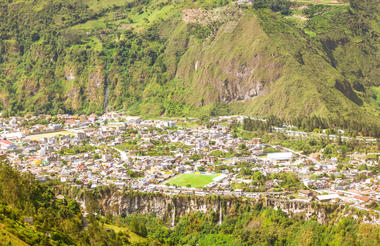

Established in 1975 as a protected area, Cotopaxi National Park – situated about 50km southeast of the capital Quito – represents the most impressive of what Ecuador has to offer by way of animals and birds, including the majestic Andean condor, as well as magnificent photographic opportunities in the form of spectacular valleys, lakes and a number of volcanoes. Centre stage is occupied by the snow-laden Cotopaxi volcano that rises to 5 890m – a favourite with mountaineers. An excursion might have you spying puma, the rare Andean spectacled bear, Andean fox or orange-headed caracara, which is endemic in the area. The ruins of Incan forts and other ancient stone building remains can be seen surrounding Santo Domingo Lake.



Quito, the capital of Ecuador, lies on the slopes of the Andes’ mighty Pichincha volcano in the Guayllabamba river basin. The city’s Old Town is its main attraction - one of the most well preserved in Latin America and the first-ever UNESCO heritage site. Wander among ancient, colourful streets; pop into glorious historic churches; or spend an afternoon browsing the vibrant Mercado (markets) and learning about the unique, traditional Ecuadorian Sierra culture. Other bucket list items in Quito include a visit to the impressive Casa Museo Guayasamín; the Museo de la Presidencia which provides insight into Ecuador’s history; and a climb up the iconic towers of the Basilica. Numerous gorgeous public parks and a thriving and exciting culinary scene complete the package.

